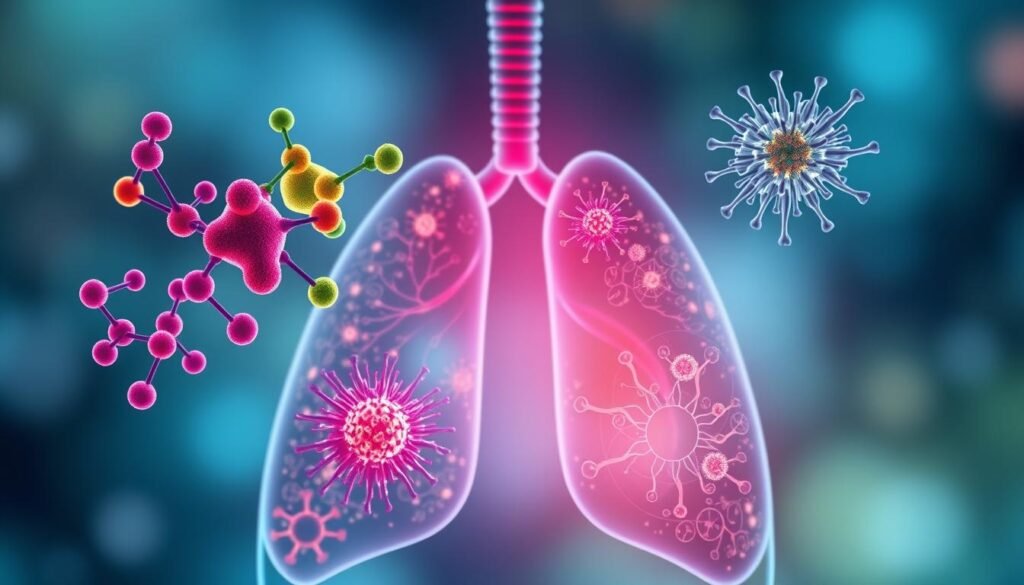Adenocarcinoma of the lung makes up nearly 40 percent of all non-small cell lung cancers (NSCLC). This fact emphasizes the need to know the treatment choices for this common disease. Adenocarcinoma, especially seen in nonsmokers, is widespread and poses unique treatment challenges and chances.
This guide will cover the treatment options for adenocarcinoma lung cancer. It will talk about surgery, chemotherapy, radiation therapy, and new treatments like targeted therapy and immunotherapy. With this information, patients and caregivers can choose treatments based on personal health needs and the specifics of the cancer.
Key Takeaways
- Adenocarcinoma accounts for a significant portion of non-small cell lung cancers.
- It is the most common type of lung cancer found in nonsmokers.
- Smoking remains the primary cause, linked to approximately 80% of lung cancer deaths.
- Diagnostic tests play a vital role in confirming lung adenocarcinoma.
- Treatment options vary depending on the cancer stage and individual health.
- Emerging therapies are continuously evolving, providing new hope for patients.
Understanding Lung Adenocarcinoma
Lung Adenocarcinoma accounts for nearly 40% of all lung cancer in the U.S. It starts in the glandular cells of the lungs, which make mucus. It’s growing in occurrence, especially in non-smokers, making it a significant concern.
What is Adenocarcinoma of the Lung?
This is the top lung cancer in people who’ve never smoked. It appears in the glands inside lung tissues. There are four types: AIS, MIA, invasive adenocarcinoma, and its variants. Knowing the type helps with treatment and figuring out the outlook.
Typical Causes and Risk Factors
It’s vital to know what causes lung adenocarcinoma for prevention. Smoking is the biggest culprit, linked to 80% of lung cancer deaths. Other risks include:
- Exposure to secondhand smoke
- Being around radon and asbestos
- Having certain genes that make you more likely to get it
These factors can increase your risk, especially for women, who are seeing more cases.
Symptoms of Lung Adenocarcinoma
Spotting symptoms early is key. Look out for:
- A cough that won’t quit
- Pain or discomfort in the chest
- Feeling short of breath
- Losing weight without trying
Early on, lung adenocarcinoma might not show symptoms. Sometimes, it’s found by accident during tests for other health problems.
| Statistic | Value |
|---|---|
| Percentage of Lung Cancers | 40% |
| Common Age of Diagnosis | 71 years |
| Annual New Cases in 2015 | 221,200 |
| Annual Lung Cancer Deaths | 158,000 |
| 5-Year Survival Rate | 12% – 15% |
Diagnosis of Adenocarcinoma Lung Cancer
To diagnose adenocarcinoma lung cancer, doctors start with the patient’s history and a physical exam. They check the patient’s smoking habits, family health history, and symptoms. A detail-focused exam by a healthcare professional identifies potential warning signs for further checks.
Medical History and Physical Examination
Reviewing a patient’s medical history is crucial in diagnosing lung cancer. It helps spot lung cancer patterns early. The physical check-up allows doctors to see the patient’s health status and note cancer signs.
Diagnostic Tests and Imaging Techniques
After the first steps, different tests and imaging methods are used. CT scans and X-rays are key for spotting lung growths pointing to adenocarcinoma. Tests on mucus and blood help find abnormal cells and markers, aiding the diagnosis.
Importance of Biopsy and Tissue Sampling
A biopsy is the sure way to diagnose lung cancer. By using methods like needle aspiration or bronchoscopy, doctors get tissue samples to examine. This step is key to confirm cancer and guide the next treatment steps. Biopsy results greatly help in choosing the best treatment path.
For more on diagnosing and treating lung cancer, check out this resource. Proper understanding of diagnosis steps helps patients and families make informed decisions about treating adenocarcinoma lung cancer.
Staging Lung Adenocarcinoma
To really get the progression of lung adenocarcinoma, you have to dig into the TNM staging system. This method checks the cancer by looking at tumor size (T), lymph nodes (N), and metastasis (M). It’s key for figuring out how advanced the cancer is, picking treatments, and predicting what might happen next.
The TNM Staging System
The TNM system is vital for grouping adenocarcinoma types. Stages in non-small cell lung cancer (NSCLC) go from 0 to IV. Stage 0 is when cancer is just starting, only in the lung lining or bronchus. Stage I is broken into 1A and 1B, showing cancer hasn’t spread beyond the lung or lymph nodes. By Stage II, the tumor grows and reaches close lymph nodes.
Stage III has sub-stages IIIA, IIIB, and IIIC, where cancer moves to lymph nodes near the heart. Stage IV is the toughest, with cancer reaching far-off body areas.
The TNM details are central for figuring out lung cancer stage:
| Stage | T (Tumor Size) | N (Lymph Node Involvement) | M (Metastasis) |
|---|---|---|---|
| 0 | Carcinoma in situ | N0 | M0 |
| I | T1 (≤ 3 cm) | N0 | M0 |
| II | T2 (3-5 cm) | N1 | M0 |
| III | T3 (5-7 cm) | N2 | M0 |
| IV | T4 (> 7 cm) | N3 | M1 |
Significance of Cancer Staging
Figuring out a cancer’s stage changes how doctors tackle it. It tells them how serious the situation is and the best way to fight it. Knowing the stage helps doctors plan treatments that target the cancer’s specifics, aiming for the best results. Thanks to the TNM staging system, tailored plans improve chances of beating cancer.
Adenocarcinoma Lung Cancer Treatment Options
Adenocarcinoma lung cancer makes up about 40% of all lung cancers. It needs a personalized treatment plan for every patient. Knowing your options ensures the best outcomes. Here’s a look at the treatment methods used for this lung cancer.
Surgery for Tumor Removal
Surgery is crucial in treating adenocarcinoma, offering a high chance for a cure. The surgery type, like lobectomy or pneumonectomy, is based on the tumor’s size and location. Lobectomy removes a lung lobe and is best for patients with localized disease. It keeps as much lung function as possible while getting rid of cancerous cells.
Chemotherapy Overview
Chemotherapy is used after surgery or for advanced adenocarcinoma. It involves intravenous medications that target and destroy rapidly growing cancer cells. For advanced cases, two chemotherapy drugs are often used together. This approach helps control the disease’s spread.
Radiation Therapy as a Treatment
Radiation therapy is key in managing lung adenocarcinoma. It uses high-energy waves to shrink tumors and ease symptoms. External beam radiation therapy (EBRT) is a common choice. It targets cancer cells and is used before or after surgery to reduce tumor size or kill lingering cancer cells.
Targeted Therapy Explained
Targeted therapy uses drugs designed for cancer cells’ genetic mutations. Drugs like alectinib and osimertinib tackle these mutations effectively. Patients undergoing targeted therapy should get biomarker testing. This identifies the most beneficial treatments.
Immunotherapy Innovations
Immunotherapy has opened new doors for lung adenocarcinoma treatment. Drugs like nivolumab boost the immune response to fight cancer cells. Checking PD-L1 protein levels and tumor mutational burden (TMB) can show if immunotherapy will work well. It’s a significant step forward in combating lung cancer.

| Treatment Method | Purpose | Ideal Candidates |
|---|---|---|
| Surgery | Remove tumor and surrounding tissue | Localized adenocarcinoma |
| Chemotherapy | Target fast-growing cancer cells | Advanced lung adenocarcinoma |
| Radiation Therapy | Shrink tumors and alleviate symptoms | Patients with local or recurrent disease |
| Targeted Therapy | Target specific genetic mutations | Patients with identified mutations |
| Immunotherapy | Enhance immune response against cancer | Patients with suitable PD-L1 levels |
Adjuvant and Neoadjuvant Therapies
Adenocarcinoma is a big part of lung cancer cases. Doctors use adjuvant therapy and neoadjuvant chemotherapy to fight it. These treatments help manage the disease and can lead to longer life for patients.
What are Adjuvant Treatments?
Adjuvant treatments are given after surgery to lower cancer’s return risk. They include chemotherapy, radiation, and targeted therapies. The Lung Adjuvant Cisplatin Evaluation (LACE) study shows these therapies can boost survival rates by 5.4%.
This means a smaller chance of dying from lung cancer. Adjuvant treatments are key in the fight against adenocarcinoma.
Benefits of Neoadjuvant Chemotherapy
Neoadjuvant chemotherapy is used before surgery to make tumors smaller. It makes the surgery easier and gives clues on how the tumor responds to treatment. Studies show it can greatly increase life expectancy, especially with a major response.
The NADIM trial had impressive results with combined therapy. It highlights the benefits of using neoadjuvant chemotherapy early on.
| Trial | MPR Rate (%) | Strategy |
|---|---|---|
| NADIM | 83 | Nivolumab + Paclitaxel and Carboplatin |
| CHECKMATE 816 | 36.9 | Nivolumab + 3 Cycles of Chemotherapy |
| NEOSTAR | 50 | Nivolumab + Ipilimumab |
| LCMC3 | 19 | Atezolizumab |
Neoadjuvant chemotherapy can tackle tumors early, before they’re surgically removed. There’s work on biomarkers to predict how well treatments will work. Understanding both adjuvant and neoadjuvant therapies can improve care for lung cancer, aiming for better survival rates.
Clinical Trials and Emerging Treatments
Clinical trials are key in the progress of medical science. This is especially true for lung cancer treatments. Patients get to try new treatments not yet widely available. Plus, their participation helps make future therapies better for everyone.
Importance of Participating in Clinical Trials
Taking part in clinical trials offers access to cutting-edge treatments. For those with lung adenocarcinoma, trials may offer tailored options. These studies test new treatments, focusing on specific mutations or markers. This not only helps patients but also aids the medical field by guiding future treatments.
Innovative Treatments in Development
A range of new treatments for lung adenocarcinoma are under investigation. Here are some notable clinical trials:
| Trial Name | Focus | Initiation Date | Projected Completion |
|---|---|---|---|
| Lung Cancer Biomarkers and Screening | Screening and biomarkers for lung cancer | 2000 | 2023 |
| Mesothelioma Targeted Therapy | Pemetrexed and Cisplatin for malignant pleural mesothelioma | November 2019 | Ongoing |
| SBRT Non-Small Cell Lung Cancer | Effectiveness of single-fraction SBRT | 2021 | 2025 |
| Neoantigen Vaccine for Small Cell Lung Cancer | Personalized neoantigen vaccines combined with durvalumab | 2022 | 2026 |
| Dialectical Behavioral Therapy | Mental health support for metastatic lung cancer patients | July 2021 | 2024 |
Trials are also looking at how different drugs work together. For details on these treatments, read the research article. These trials show the promise of personal and effective care for lung adenocarcinoma patients.

Managing Side Effects of Treatment
Treatment for lung adenocarcinoma comes with side effects that can affect daily life. It’s vital to understand these side effects. This understanding helps manage them and keep a good quality of life during treatment.
Common Side Effects of Chemotherapy
Chemotherapy brings various side effects. Some common ones are:
- Nausea and vomiting
- Fatigue
- Hair loss
- Increased risk of infection
To manage these, patients might need medication and supportive care. Anti-nausea meds can ease sickness. Staying hydrated and eating well are also key.
Addressing Radiation Therapy Side Effects
Side effects from radiation may include skin issues, tiredness, and breathing problems, especially if the chest is affected. Management techniques include:
- Applying soothing skincare products for irritation
- Resting adequately to combat fatigue
- Utilizing nebulizers or oxygen concentrators for respiratory support
Those getting treatment should avoid alcohol; it can make skin irritation worse. Soft foods, like yogurt and soups, help if swallowing is hard.
Emotional Support and Resources
Being diagnosed with cancer is emotionally tough. Finding emotional support is crucial. There are resources like:
- Support groups connecting individuals facing similar challenges
- Therapy sessions to explore emotional health
- Counseling services designed to address specific concerns
Having strong emotional support is important. It helps people feel less alone in their treatment journey. This allows them to focus more on getting better and worrying less.
Prognosis for Lung Adenocarcinoma Patients
It’s very important to understand the prognosis for lung adenocarcinoma patients. Knowing this helps both patients and their doctors. Various factors play a big role in what to expect. This includes the stage of the cancer, the patient’s health, and how the tumor reacts to treatment.
Factors Influencing Prognosis
The outlook for patients varies greatly due to several key factors:
- Cancer Stage: If the cancer is just in one place, outcomes are generally better than if it has spread.
- Patient Health: A person’s overall health and other health issues can affect how they respond to treatment and recover.
- Response to Treatment: How well a patient’s cancer responds to treatment can greatly affect their chances of survival.
- Individual Tumor Biology: Differences in the tumor can mean different outcomes for patients.
Age at diagnosis also makes a big difference. Younger patients usually live longer than those who are over 75. Studies show that being younger at the time of diagnosis leads to a better outlook.
Role of Biomarkers in Predictions
Biomarkers have become very important in predicting how well treatments work and what a patient’s outcome might be. They offer clues about:
- Customized Treatment Approaches: Using biomarkers to guide therapy can increase the chance of success.
- Projected Survival Rates: Biomarkers can help predict how long a patient might live, helping with planning.
- Identifying Cancer Characteristics: Knowing the details of a tumor can show how it might act and respond to treatments.
Looking at both prognosis factors and biomarkers is key to understanding and improving results for lung adenocarcinoma patients. A well-rounded treatment plan that considers these aspects can offer better strategies for care and increase survival chances.

Strategies for Prevention and Early Detection
Being proactive is key in reducing lung cancer risk and improving survival rates. Early detection is crucial.
It’s critical for people at risk to focus on prevention. This is especially true for heavy smokers. Quitting smoking is the biggest step one can take. Smoking is linked to about 90% of lung cancer cases. Thus, stopping smoking is crucial for better treatment results in adenocarcinoma cases.
Quit Smoking and Its Benefits
Quitting smoking greatly lowers the chance of getting lung cancer. People who quit see a significant risk reduction over the years. After ten years, the lung cancer risk can drop by 30% to 60%.
People at higher risk, like those aged 55 to 80 with a heavy smoking history, should prioritize quitting. Smoking heightens the impact of other risk factors.
Screening Recommendations
High-risk individuals are advised to get regular lung cancer screenings. They should use low-dose CT scans. These scans help find cancer early, which improves survival rates. The current advice is to screen people aged 50 to 80 with a heavy smoking history or those who quit in the last 15 years.
Talking to healthcare providers about screening is vital. Better screening means better outcomes. For detailed lung cancer screening info, visit lung cancer screening guidelines.
| Prevention Strategy | Description |
|---|---|
| Quit Smoking | Reduces lung cancer risk significantly, especially after 10 years of cessation. |
| Lung Cancer Screening | Regular CT scans for high-risk individuals aid in early detection. |
| Reduce Exposure | Avoid occupational and environmental carcinogens, including radon and asbestos. |
| Healthy Lifestyle | Balanced diet rich in fruits and vegetables may offer some protection. |
Conclusion
The treatment overview for adenocarcinoma shows how tough lung cancer is to handle. This type is very common, making up about 40% of all lung cancer cases. Yet, there’s hope due to the wide range of treatments available. These include chemotherapy, targeted therapies, and immunotherapy, all customized for the patient’s specific needs. Research and clinical trials are key in finding new treatments, showing why raising lung cancer awareness is crucial.
Spotting lung cancer early is vital for treatment success. Unfortunately, only a small percentage of patients live more than five years after finding they have lung cancer. Emphasizing the need for awareness, regular checks, and tailored treatment plans is essential. Reviewing treatment options helps doctors and patients make choices that improve survival and life quality.
For those battling lung cancer, joining clinical trials might offer access to new treatments. Building a support network and increasing knowledge about lung adenocarcinoma can change many lives. This can give hope to those dealing with this tough diagnosis.